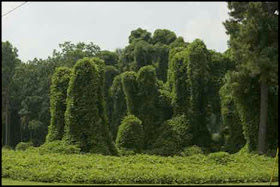During the Great Depression of the 1930s, the Soil Conservation Service promoted kudzu for erosion control. Hundreds of young men were given work planting kudzu through the Civilian Conservation Corps. Farmers were paid as much as eight dollars an acre as incentive to plant fields of the vines in the 1940s. The problem is that it just grows too well! The climate of the Southeastern U.S. is perfect for kudzu. The vines grow as much as a foot per day during summer months, climbing trees, power poles, and anything else they contact. Under ideal conditions kudzu vines can grow sixty feet each year. While they help prevent erosion, the vines can also destroy valuable forests by preventing trees from getting sunlight. This problem led Dr. James H. Miller of the U.S. Forest Service in Auburn, Alabama to research methods for killing kudzu. In eighteen years of research, he has found that one herbicide actually makes kudzu grow better while many have little effect. Miller recommends repeated herbicide treatments for at least four years, but some kudzu plants may take as long as ten years to kill, even with the most effective herbicides.










































No comments:
Post a Comment